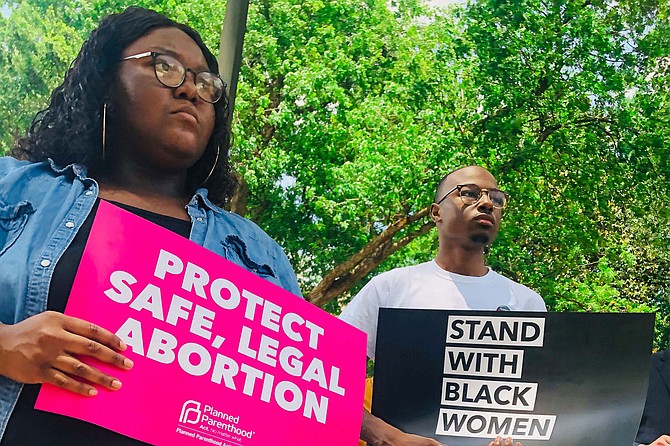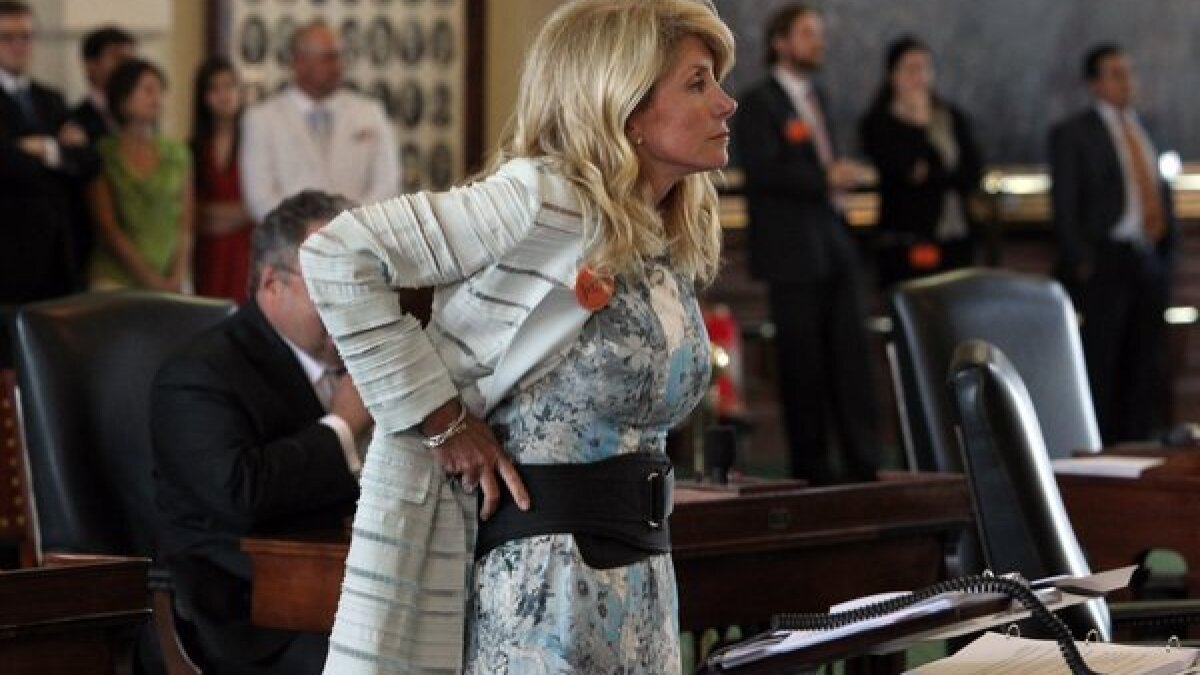To honor the anniversary of Roe v. Wade’s historic passage, we’ve built a timeline of Roe v. Wade, abortion restrictions in America, and our ongoing relentless fight for reproductive freedom.
In 2022, just shy of Roe v. Wade’s 50th anniversary, the U.S. Supreme Court struck down the landmark decision with its ruling in Dobbs v. Jackson Women’s Health Organization.
Now, millions have zero access to abortion in their home states—and Texas’ abortion ban is one of the strictest in the country. But anti-abortion courts and policymakers haven’t stopped their overreach of power at overturning Roe.
In December 2023, the Texas Supreme Court denied a Texas woman an abortion under the ban’s narrow exceptions—even though her pregnancy was not viable—forcing her to leave the state. At the beginning of 2024, the 5th Circuit ruled that Texas hospitals are not required to perform lifesaving abortions. In the summer, the U.S. Supreme Court will rule on a case seeking to bar national access to mifepristone.
As we peer into Roe v. Wade’s timeline, let us be abundantly clear: We will not be idle or silent while the state holds our bodies hostage. We’ll learn from our history as we build a future that goes beyond Roe. Together, we can have more freedom over our own bodies than we have ever known.
/cloudfront-us-east-1.images.arcpublishing.com/dmn/PJMT3OA7DNDVLGOYNTFDZ4F7DI.JPG)
SARAH WEDDINGTON, THE ACTIVIST WHO ARGUED ROE V. WADE
Abortion Access in America: A Timeline
Let’s jump way back for some context—to 1847!
1847: The American Medical Association is formed & begins criminalizing abortion
Doctors around the country form the American Medical Association, and the male-dominated body notably takes aim at reproductive healthcare and workers in the field. By attacking abortion practices and claiming that the medical procedure was “unsafe,” doctors, who were not historically held in high esteem, could “denounce amateurs” and begin cementing themselves as the true American medical authority.
It should be noted that until the professionalization of medicine in the mid-1800s, abortion was a common and accepted practice in the United States—there were even advertisements for abortion services in newspapers.

Unsurprisingly, the crusade to criminalize abortion and standardize medical practices coincided with conservative society’s growing concern that white, affluent families were becoming smaller in size compared to recent immigrant families due to the wealthy’s access and ability to have a hand in family planning.
1880 – 1930: The “century of criminalization” begins, abortion is banned nationwide, and death rates from unsafe abortions rise
By 1880, every state had laws that restricted abortion care at varying levels—with some states allowing the medical procedure to save a patient’s life, at the discretion of their (likely male) doctor. With the criminalization, the stigma surrounding the procedure began to grow.
Fast forward to 1910, and these restrictions had become outright bans on abortion in every state, at every stage of pregnancy. Again, the cultural driving force was the worry that “upper-class” white women were not having enough children. By 1930, 18% of maternal deaths in the country were the result of unsafe, illegal abortions.
1955 – 1964: The fight for abortion law reform officially begins
In response to the rising number of deaths caused by illegal abortions and the growing media coverage, Planned Parenthood organized a conference in 1955 called “Abortion in the United States.” During testimony, doctors attending publicly called for abortion law reform.
The conference launched a national discussion on reformed abortion laws, and in 1962, a pregnant TV host’s public journey to obtain an abortion gave the issue more national spotlight. She’d ingested a drug called thalidomide, which causes severe birth defects, and had to travel to Sweden for the procedure. 52% of Americans supported her as the story drew more support for abortion law reform, and by 1964, abortion law reform activists registered their first national group: the Association for the Study of Abortion.
1973: Roe v. Wade

The Supreme Court recognizes for the first time that the constitutional right to privacy “is broad enough to encompass a woman’s decision whether or not to terminate her pregnancy.”
Roe v. Wade protected the right to make your own reproductive healthcare decisions in all 50 states, making access to abortion safer than it had ever been—although its protections were never been enough to make abortion care easily accessible to everyone in the United States.
The reality remained that people of color, young people, and people of low income still saw obstacles to receiving access to abortion care. An onslaught of restrictions would follow the landmark decision.

Fast forward to 2003 in Texas
2003: Texas passes the “Women’s Right to Know Act”
:quality(75)/https://static.texastribune.org/media/images/2016/07/26/WRTK-LeadArt.jpg)
State lawmakers passed the “Women’s Right to Know Act,” which mandates that doctors give medically inaccurate info to patients about abortion procedures and counsel them to explore alternative options—all laid out in state-provided pamphlets. Then, patients are forced to wait 24 hours after their first appointment to have the actual medical procedure, and all abortions at 16 weeks or more have to be performed in an ambulatory surgical center, which is a mini-hospital. None of Texas’ 54 non-hospital providers met the standard of an ambulatory surgical center when the law took effect in 2004.
2005 – 2011: Sonogram required pre-procedure & minors required to get parental consent
In 2005, Texas enacted a law requiring minors to get parental consent before they could obtain abortions. Then, in 2011, the state began forcing patients to undergo a sonogram, listen to the fetal “heartbeat,” and receive a verbal explanation of the sonogram results 24 hours before they could have an abortion.
2013: Wendy Davis’ Fillibuster & HB2

Texas passed House Bill 2, or “HB2” as it is commonly known, a robust abortion bill that imposed several additional restrictions on abortion, inspiring former Senator Wendy Davis’ famous 13-hour filibuster. One restriction banned the procedure after 20 weeks post-fertilization unless a patient is at risk of death or the fetus has a severe medical problem.
2016: Texas’ attempt to force burial or cremation of any tissue resulting from an abortion
In an act of cruelty that could be in no way linked to health or safety, Texas began requiring clinics to pay extra money to bury or cremate any tissue resulting from an abortion. Reproductive rights advocates challenged this law, and it was stopped from going into effect.
2017 – 2019: Minimizing access by targeting insurers & other financial avenues for abortion
After years of various attempted restrictions, Texas bans insurers from covering abortion in comprehensive health insurance plans, requiring people to purchase separate coverage for abortion care in 2017.
In 2019, the strategy to make abortion financially inaccessible continued with Senate Bill 22—which was created to essentially defund Planned Parenthood. The bill “prohibits certain transactions between a governmental entity and a provider or affiliate of the provider.” Essentially, cutting off any abortion care for communities that rely on low-cost clinics like Planned Parenthood—and this law doesn’t just harm abortion access. Many clinics that lost funding were the only ones in their area that provided basic necessities like birth control, annual preventative exams, cancer screenings, and diabetes testing at an affordable cost. Some didn’t even provide abortions, but they lost funding all the same.
:quality(75)/https://static.texastribune.org/media/images/2016/06/27/_Choiceworks012_room.jpg)
2021: Senate Bill 8, a six-week abortion ban, becomes law and Texans preview an effectively post-Roe world
Senate Bill 8 became law in September 2021. It allows private citizens to sue providers—or anyone allegedly involved in “aiding and abetting” the medical procedure—over abortions performed after six weeks. This is before most people know they’re pregnant.
This cruel law took government overreach to a new level by expanding what the government can do to our bodies and controlling abortion providers’ ability to perform safe medical procedures. In addition, not allowing Texans to make their own healthcare decisions quickly overwhelmed clinics and providers in neighboring states.
May 2022: A SCOTUS opinion overturning Roe v. Wade is leaked
On May 2, 2022, a leaked draft of the Supreme Court majority opinion was released. It suggested that the U.S. Supreme Court intended to strike down Roe v. Wade. While the ruling was not final, providers, advocates, and community members braced for the worst. Rallies were held around the world as millions proudly proclaimed that abortion is a human right.


June 2022: SCOTUS releases their official opinion on Dobbs, overturning Roe v. Wade
On June 24, 2022, the Supreme Court of the United States released a ruling overturning Roe v. Wade, decimating our last nationwide legal line of defense for abortion access.
July and August 2022: Abortion clinics cease operations and the Texas Trigger Ban goes into effect
On July 3, 2022, abortion clinics in Texas ceased operations, and by August 25, 2022, our “trigger law” was officially in effect. The “trigger” law, House Bill 1280, bans abortion from fertilization and criminalizes any attempt by a medical professional to perform, induce, or attempt an abortion. The law increases the penalties for performing an abortion up to life in prison. The trigger law also says that the attorney general “shall bring a lawsuit to seek a civil penalty of no less than $100,000 per abortion performed.”
December 2023: The Texas Supreme Court denies Kate Cox an abortion, proving the ban’s medical exceptions useless
The only exception to Texas’ abortion ban is cases where the person carrying the pregnancy could be severely injured or lose their life. However, advocates and medical professionals have continuously raised concerns about the vagueness of the law and the lack of guidance about who truly meets the criteria for an abortion.
In December 2023, Kate and Justin Cox sued the state of Texas for the right to have an abortion under the medical exemptions to the ban after they found out at 20 weeks that their pregnancy was not viable due to a rare genetic disorder. While a Travis County judge granted a temporary restraining order against the abortion law so that Kate could receive necessary medical care, the Texas Supreme Court ultimately blocked the lower court’s ruling—forcing Cox, already a mother of two, to flee her home state for abortion care.
Abortion bans have never been about the sanctity of life. Abortion bans are about control.
Roe was the law of the land for almost half a century, and it deserved to be protected. While the devastating impact of the Dobbs ruling grows, we cannot let anti-abortion cruelty and rhetoric distract us.
Even in the face of continued attempts to control our bodies and steal our freedoms, our fight to make abortion permanently legal, safe, and accessible for everyone cannot and will not stop. Our care for our communities cannot stop.
